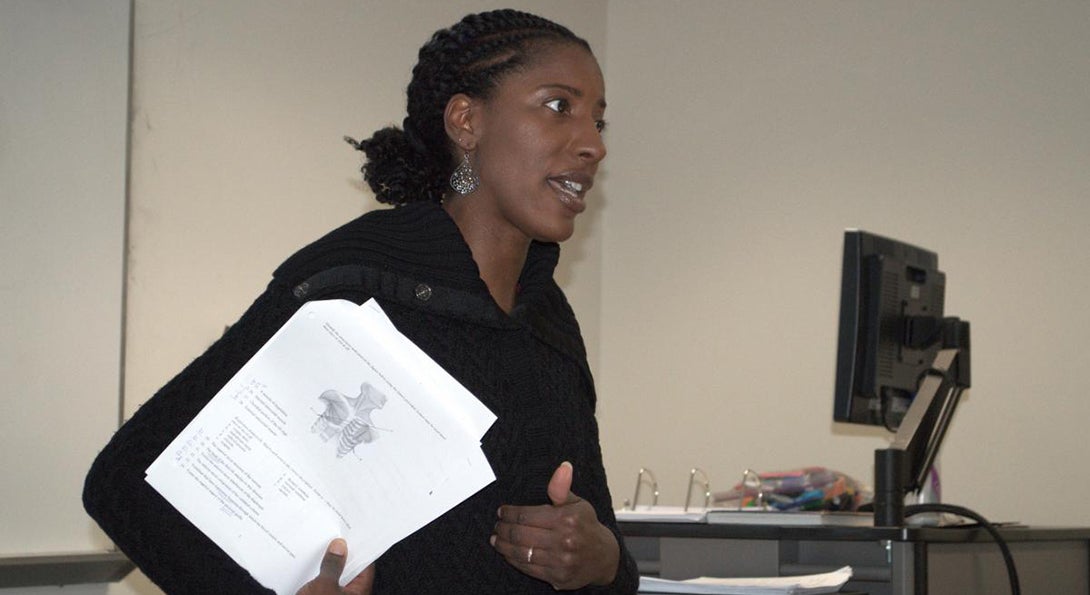Dialect and Improper Special Education Diagnoses

What should a teacher do when a Black child uses the word “aks” instead of ask?
Finding the answer requires a journey back in time to the 1300s, when both words co-existed peacefully, living the verb life side by side, sharing a bond of friendship, let alone common meaning.
Fast forward 700 years, and no one is quite sure why the two words took such divergent paths like bickering adult siblings: one to mainstream acceptance, and the other to stigmatism.
While linguists could probably debate the theories behind this historical schism, the challenges of rejected language have very practical consequences for African American English-dialect speakers from low-income backgrounds. Uses of words and phrases such as “aks” can be a one-way ticket to special education services.
At Governors State University, College of Education alumna Nicole Koonce, PhD Special Education alumna, is investigating the connections between language and literacy skills and seeks to reconsider long-accepted connections that have arisen between the two. As an assistant professor of communication disorders, her research has shown young African American dialect speakers from low-income environments perform no differently on literacy assessments than their peers.
“There’s a lot of research designs based on looking at one group and comparing to another group, but what can happen when working with kids from minority backgrounds, we always look at it from a perspective of deficit,” Koonce said. “That deficit might not be because of a particular community or racial characteristic, but it can be coded in the research as that.”
For years, Koonce worked as a school-based speech language pathologist, watching children who started with a speech or language deficit progress into classifications of full-fledged learning disabilities. She instinctually recognized connections between well-preserved language skills and how deficits in language mapped onto building strong literacy skills.
Her replication study examined third and fourth-grade students and how their narrative storytelling skills related to reading comprehension. While much research focuses on the language development of African American students in early childhood, surprisingly not much is known about how Black children’s language continues to develop past their youngest years.
Koonce’s study examined pragmatic language skills—how children use language to effectively communicate with their listener. Some research analyzes children’s communication abilities by the richness of their vocabulary or how children combine words in a sentence. Koonce says an implicit assumption exists that how children mold vocabulary and syntax translates into strength of language usage, but her analysis indicated no correlation between those aspects and language. Bulky, complex sentences do not necessarily translate into informative sentences.
Meaning seems to derive from context and topical focus, and Koonce found African American dialect speakers from low-income backgrounds are just as successful as their peers in initiating communication, maintaining topics appropriately and applying informative content in expository language.
Koonce aims to use her findings as part of a strengths-based model for language and literacy instruction she hopes teachers will employ in the classroom. Rather than viewing differences in language as a hurdle disadvantaging a child, Koonce says language viariation should be leveraged as strength to build on. She says teachers who are not dialect speakers often regard dialect as an incorrect form of using language but believes educators need to view language that is used comfortably in the home and with friends as a powerful tool for the classroom environment.
She recommends best practices employed at school districts around the country, including using teacher code switching to build academic language skills. In this manner, teachers blend the language of school (socially-accepted English dialects) with a child’s dialect speaking to slowly introduce the language a child will need to access for success in school. Bouncing back and forth between language can be an appropriate form for interaction with audiences.
“If you demystify dialects and see there’s a rule-based approach in dialects to using language, you can actually strengthen a child’s awareness of when it is appropriate to use one type of language versus another,” Koonce said. “We have to be sensitive to that because you do not want to stigmatize a child and actually block them from learning.”